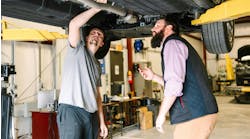Competing with consolidators and changing MSO business models
I find it fascinating how our industry evolves, often in unanticipated ways. In the 1990s and early 2000s, consolidation was at the forefront of discussion. DRPs were becoming prominent at the same time and consolidators seized the opportunity to grow their businesses. For a long time, we talked about the “big four” consolidators and that became the “big three.” In recent years, our industry has seen an influx of equity capital investment and we have another wave of (primarily) regional MSOs growing through acquisition and consolidation. Many MSOs have sold their businesses to consolidators of various sizes. The direct repair program (DRP) landscape is changing, and we now have more and more OEM-certified shops. The insurance landscape is changing, also, including the advent of a number of vehicle manufacturers getting into the auto insurance business.
So, if you represent a small or medium sized MSO that hasn’t — and doesn’t want to — sell to a consolidator, how do you compete? What is the best strategy for you going forward? How might you adjust your business model?
Do you wish to compete on the same terms?
I believe it is safe to say that the largest consolidators (the big three) and most of the new wave of consolidators have built, continue to build, and support their businesses on close relationships with insurers and DRPs. They use their size to negotiate the most favorable terms for parts and supplies. They work closely with insurers to comply with their policies/procedures, striving to accomplish success in exceeding the insurer’s key performance indicator (KPI) benchmarks. Cost containment, as typically measured by average repair cost severity, is a major component. And maintaining lower cost of shop operation helps to be able to afford keeping severity in check. DRPs simply come with some, or many, concessions. In exchange, the insurers refer a great deal of work to these large companies. This arrangement also keeps marketing costs down for consolidators, as essentially the insurer’s DRP does the marketing for the consolidator.
So, if you have a medium or small MSO and wish to compete in the world of DRPs, then you will have to compete in terms of cost containment and KPI performance. Many repairers have been trying to do that for years. Some are successful at it. It does mean you will probably be using many alternative parts and you will have to be a tough negotiator with your suppliers. You will have to be willing to absorb many costs such as some vehicle storage and total loss administration. Mastering the art of balancing quality repairs with cost, speed of repairs, while pleasing both consumers and insurers will be your priorities. But, in exchange you will get a more dependable stream of incoming work. And you will be able to process claims quicker, due to the authority which the insurer provides to you.
I personally believe that this is one way to compete, but it is challenging because the very size of the consolidator you are competing with gives them a competitive edge. And many of them have mastered processes that help provide great KPI scores.
Alternatives
An alternative to the DRP model that is increasing in popularity is having no DRPs or few DRPs. It means building your business, or changing it, with a different mindset. It means less emphasis on insurance relationships and KPIs, but more emphasis on great customer service and customer relationships. It means that you may have to increase marketing efforts, especially salesmanship when that potential customer reaches out to your business. You will have to provide reasons for customers to choose to do business with you.
This business model is different in many ways but can provide an alternative to help your MSO compete. Understand that you will be competing in a different way that will result in many customers that are different than those who do business with the large consolidators. In many cases, these customers will be more decerning regarding the quality of the repair and the level of service.
Having fewer, or no, DRPs means that it will take a different approach in getting insurance claim and supplement approvals, which is slower and more cumbersome. But because there is less focus on containing cost for the insurer and more focus on quality, you will no doubt be using more OEM and fewer alternative parts. You will be able to charge for some things normally conceded in a DRP like storage, tow markups, and administrative costs.
Vehicle manufacturer certifications typically work in better harmony with this business model, primarily due to repair procedure and parts requirements. Certification programs can be very expensive to implement and maintain. A business model designed more around getting paid for necessary steps instead of cost concessions is more attainable when not having to focus as much on pleasing the insurer. Complying with the requirements of such certifications and manufacturer repair procedures provides specific line items that can be proven and thus charged for. Having these certifications differentiates your MSO from the consolidator, and they have been less inclined to embrace them to any large extent.
You may also consider some hybrid versions of this model. As I mentioned, manufacturer certifications can be expensive. Instead of seeking all or most certifications you may elect to focus on select vehicle brands. Perhaps you have shops within an area whose demographics lean towards certain brands, and thus you can avoid that cost and other challenges of training and equipping for those vehicles you see less frequently. You may become a respected expert and may use that as a tool to help with dealership relationships.
The changing landscape
As you contemplate different business models to help you compete, consider some current industry trends. I believe they are making these alternative models more and more attractive.
I believe consumers are changing in how they make purchasing decisions. With our increasing dependance on on-line communication and shopping more people rely on in-line reviews, especially the five-star rating systems. With our highly polarized society, I believe people are more skeptical and thus more likely to get more feedback, such as from friends, relatives, and co-workers. People are less likely to trust large institutions such as insurers for advice. From my own experience, I’ve been pleasantly surprised that ending a DRP relationship doesn’t necessarily reduce sales volume as much as is feared and that it did in the past.
The three major entities of influence in our industry are vehicle manufacturers, repairers, and insurers. In the past, it seemed that the insurers typically had the most control and influence. Increased vehicle complexity, increased safety concerns, and an increased involvement by manufacturers in our industry has increased their influence. Especially we as repairers have become quite dependent upon them for repair procedures, repair technologies, and shop certifications. Insurer influence has declined somewhat as a result. Repairers have become bolder in seeking higher labor rates and minimizing concessions to insurers, in part due to staff shortages and inflation and rising costs to keep up with technologies. In other words, largely out of necessity. And market conditions are good for shops. Most are scheduling work out for weeks or months. Thus, we are starting to see some trends that are unprecedented. Labor rates are increasing at unheard of pace. I’ve seen examples of insurers paying higher rates to keep a quality shop on their DRP. We are seeing evidence of customers being more and more influenced by manufacturer certification, choosing those shops no matter what the insurer recommends. One industry consultant I know has said publicly that he believes that DRPs are dying a slow death.
I find there is an element in these alternative business models that feels good. It feels like there is more focus on safety, on doing the right thing for the consumer and their vehicle. While the insurers still have immense influence, there is less of a feeling of a master/servant relationship that we as repairers have felt when dealing with some insurers. More feeling of independence and self-reliance.
Therefore, I believe the time is better than ever to contemplate alternative business models to help your small or medium sized MSO compete.
The important thing is that you consider your options and create a plan on how to compete. There are alternatives to traditional models and ways that you can compete without playing by exactly the same rules.




